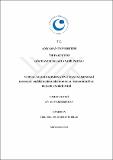Vernal keratokonjonktivit hastalarındaki korneal değişikliklerin korneal topografi ile değerlendirilmesi
- Global styles
- Apa
- Bibtex
- Chicago Fullnote
- Help
Abstract
Amaç: Bu çalışmada, kliniğimizdeki vernal keratokonjonktivit (VKK) hastaların korneal topografik değişikliklerinin Sirius korneal topografi ile değerlendirilmesi ve sağlıklı kontrol grubu ile karşılaştırılması amaçlanmıştır.Gereç ve yöntem: Bu çalışmaya; VKK grubu 112 hastanın 224 gözü ile sağlıklı 114 gönüllünün 228 gözü alındı. Hastaların ve sağlıklı grubun; yaşı, cinsiyeti, en iyi düzeltilmiş görme keskinliği Snellen eşeline göre değerlendirildi. Her katılımcıya Goldmann aplanasyon tonometresi ile göz içi basıncı ölçümü, biyomikroskopik muayenesi, fundus muayenesi yapıldı. Korneal topografi, tüm hastalara deneyimli bir teknisyen tarafından Sirius (Cso, Floransa, İtalya) ile çekildi.Bulgular: Gruplar arasında yaş ve cinsiyet açısından anlamlı fark saptanmadı (p>0,05). VKK grubu 112 kişinin 224 gözü değerlendirildiğinde 65 (% 29) göz tarsal, 101 (% 45) göz limbal ve 58 (% 26) göz karışık tip VKK görüldü. Santral kornea kalınlığı, minimum kornea kalınlığı değerleri VKK grubunda kontrol grubuna göre anlamlı olarak daha düşük saptandı (p<0.0045). Arka simetri endeksi (SIf), keratokonus ön tepe noktası (KVf), keratokonus arka tepe noktası (KVb), Baiocchi Calossi Versaci front (BCVf), Baiocchi Calossi Versaci back (BCVb) değerleri VKK grubunda kontrol grubuna göre anlamlı olarak daha yüksek saptandı ((p<0.0045). Kornea hacmi, simülasyon keratometri 1(Sim K1), simülasyon keratometri 2 (Sim K2), ön simetri endeksi (SIf) değerleri her iki grup arasında anlamlı fark saptanmadı (p>0.0038). Sirius korneal topografi sistemi ile VKK grubunda 224 göz topografik olarak tanı sınıflamasına göre değerlendirildiğinde; 159 (% 71) göz normal, 35 (% 15,6) göz anormal, 17 (% 7,6) göz keratokonus şüphesi, 13 (% 5,8) göz keratokonus olarak sonuçlandı. Kontrol grubu 114 kişininin 228 gözü topografik olarak tanı sınıflamasına göre değerlendirdiğinde; 228 göz (% 100) normal olarak sonuçlandı. VKK alt tipleri topografik olarak tanı sınıflamasına göre değerlendirildiğinde; gruplar arasında anlamlı fark saptanmadı (p=0.078). Topografik olarak keratokonus tanısı alan hastaların normal tanı alan hastalara kıyasla yaş ortalaması istatistiksel olarak anlamlı daha yüksek saptandı (p<0,05). Keratokonus tanısı alan hastaların normal tanı alan hastalara kıyasla, en iyi düzeltilmiş görme keskinliği Snellen eşeline göre istatistiksel olarak anlamlı daha düşük saptandı (p<0,05).Sonuç: Çalışmamızda, VKK grubu kontrol grubuna kıyasla anormal kornea lehine topografik değişiklikler ve daha fazla oranda keratokonus ve keratokonus şüphesi görülmüştür. Bu nedenle, VKK hastalarının takiplerinde korneal değişikliklerin değerlendirilmesi ve keratokonusun erken teşhisi için topografik tetkiklerin kullanılması faydalı olacaktır. Objective: In this study, we aimed to evaluate corneal topographic changes of patients in our clinic with vernal keratoconjunctivitis by using Sirius corneal topography and compare them with healthy control groupMaterials and Methods: 224 eyes of 112 patients with VKK group and 228 eyes of 114 healthy volunteers were included in this study. The age, the gender and the best corrected visual acuity of the patients and the healthy group were evaluated based on the best corrected visual acuity measured by Snellen Chart. Intraocular pressure measurement by Goldmann applanation tonometry, slit lamp examination, and fundus examination for each participant were performed. Corneal topography of all patients was taken by an experienced technician with Sirius (Cso, Florence, Italy).Results: There was no significant difference between groups in terms of age and gender (p> 0.05). Of 224 eyes of 112 patients with VKK, 65 (29 %) were tarsal type, 101 (45 %) were limbal type and 58 (26 %) were mixed type VKK. Central corneal thickness and minimum corneal thickness values were significantly lower in VKK group than in the control group (p<0.0045). Symmetry Index back (SIb), Keratoconus Vertex Front (KVf), Keratoconus Vertex Back (KVb), Baiocchi Calossi Versaci front (BCVf) and Baiocchi Calossi Versaci back (BCVb) values were significantly higher in VKK group than in the control group (p<0.0045). There was no significant difference between both groups for corneal volume, Symmetry Index front (SIf) values, Simulation Keratometry 1 (Sim K1) and Simulation Keratometry 2 (Sim K2), (p> 0.0038). When 224 eyes in VKK group were classified by Sirius topography system according to topographically diagnostic classification; 159 (71 %) were resulted in normal, 35 (15.6 %) were resulted in abnormal, 17 (7.6 %) eyes were resulted in suspected keratoconus and 13 (5.8 %) eyes were resulted in keratoconus. When 228 eyes of 114 subjects in control group were evaluated according to topographically diagnostic classification; 228 (% 100) eyes were normally resulted. When VKK subtypes were evaluated according to topographically diagnostic classification; there was no significant difference between groups (p=0.078). The average age of patients topographically diagnosed with keratoconus was statistically higher than that of patients normally diagnosed (p<0,05). Best corrected visual acuity measured by Snellen chart was statistically lower in keratoconus patients compared to the healthy subjects (p<0,05).Conclusion: In this study, abnormal corneal topographic changes, keratoconus rates and keratoconus suspect rates were higher in VKK group compared to the control group. Therefore, the use of topographic examination may be useful for evaluation of corneal changes and for early keratoconus diagnosis in the follow-up of VKK patients.
Collections


